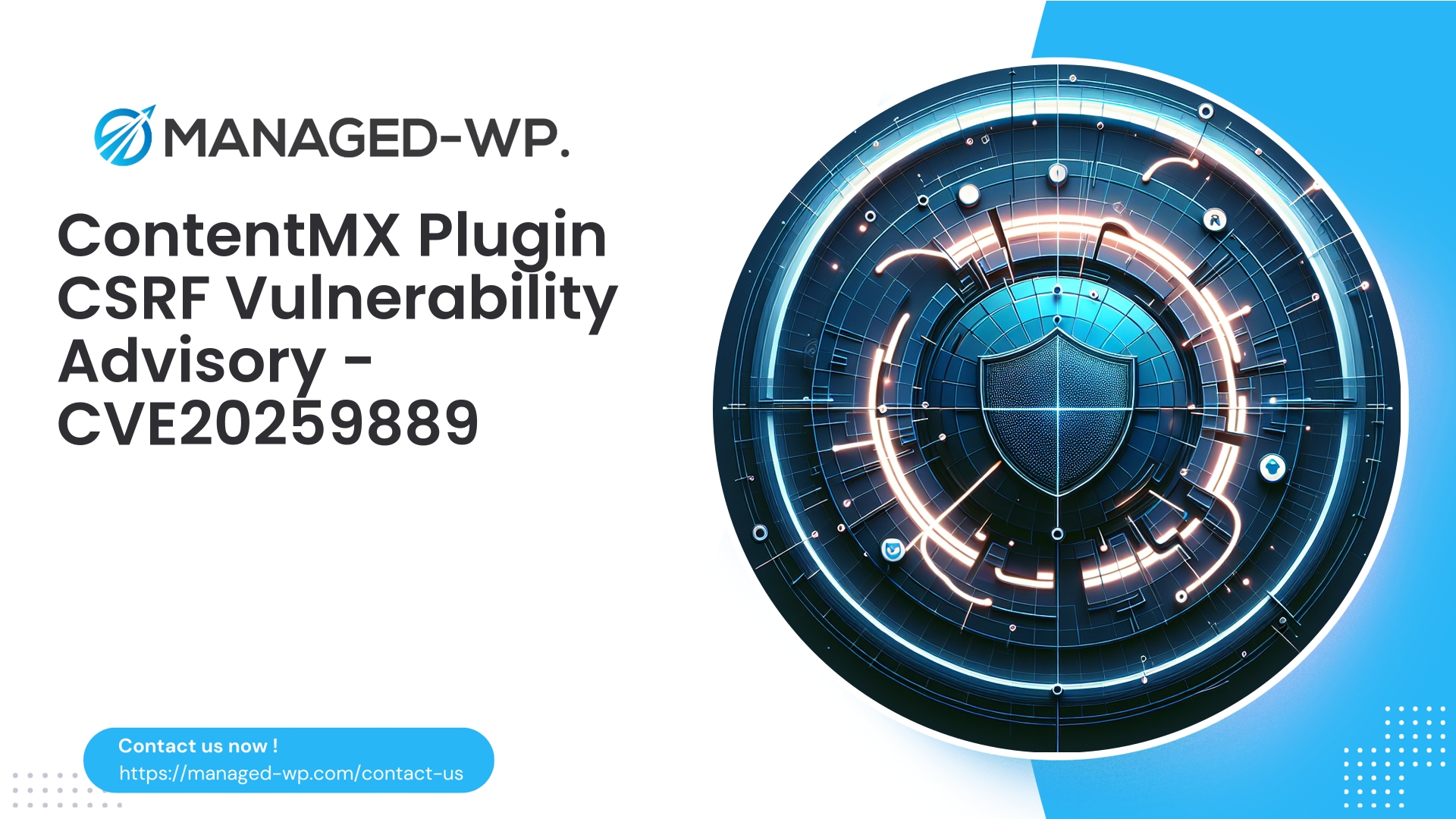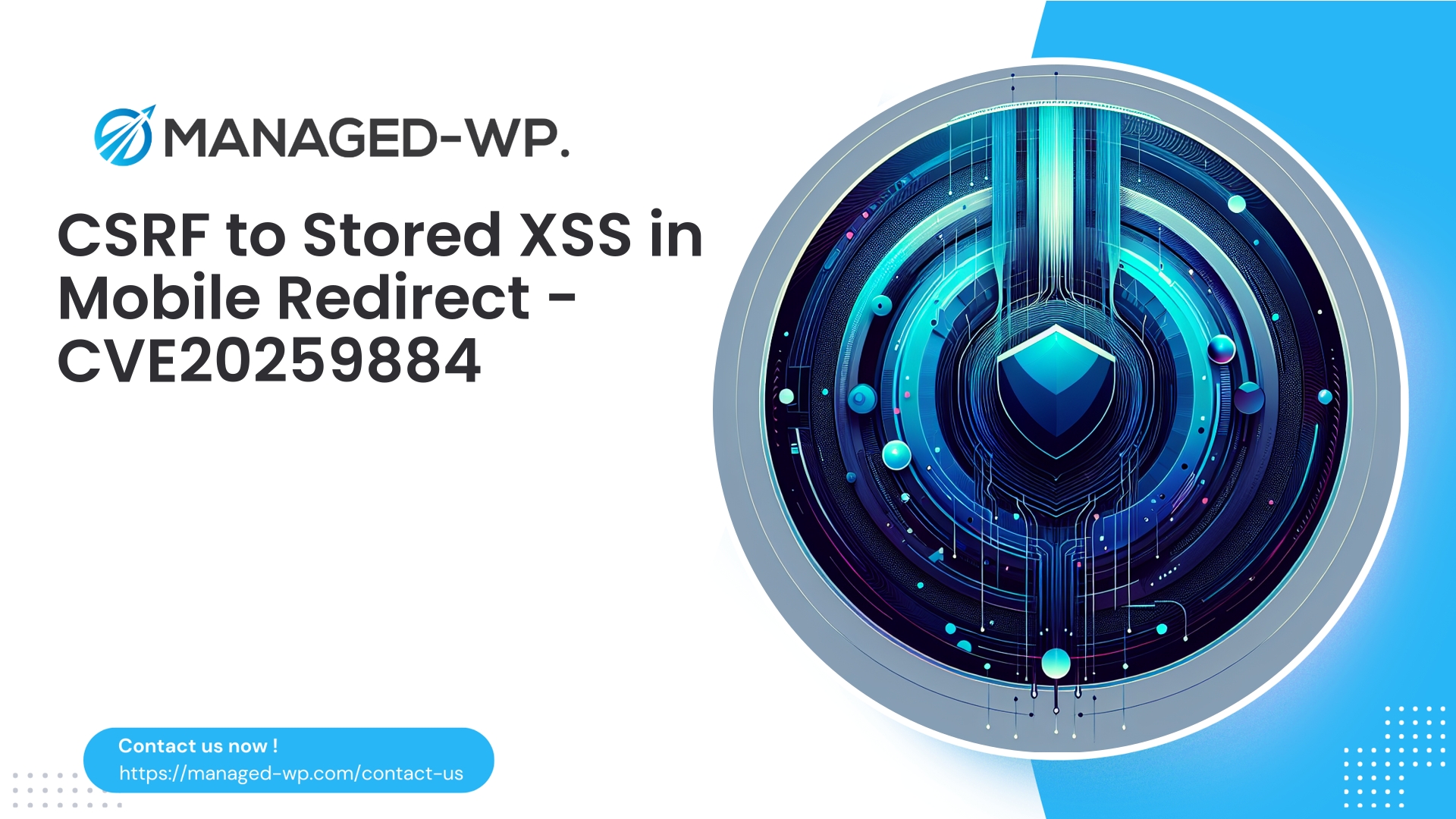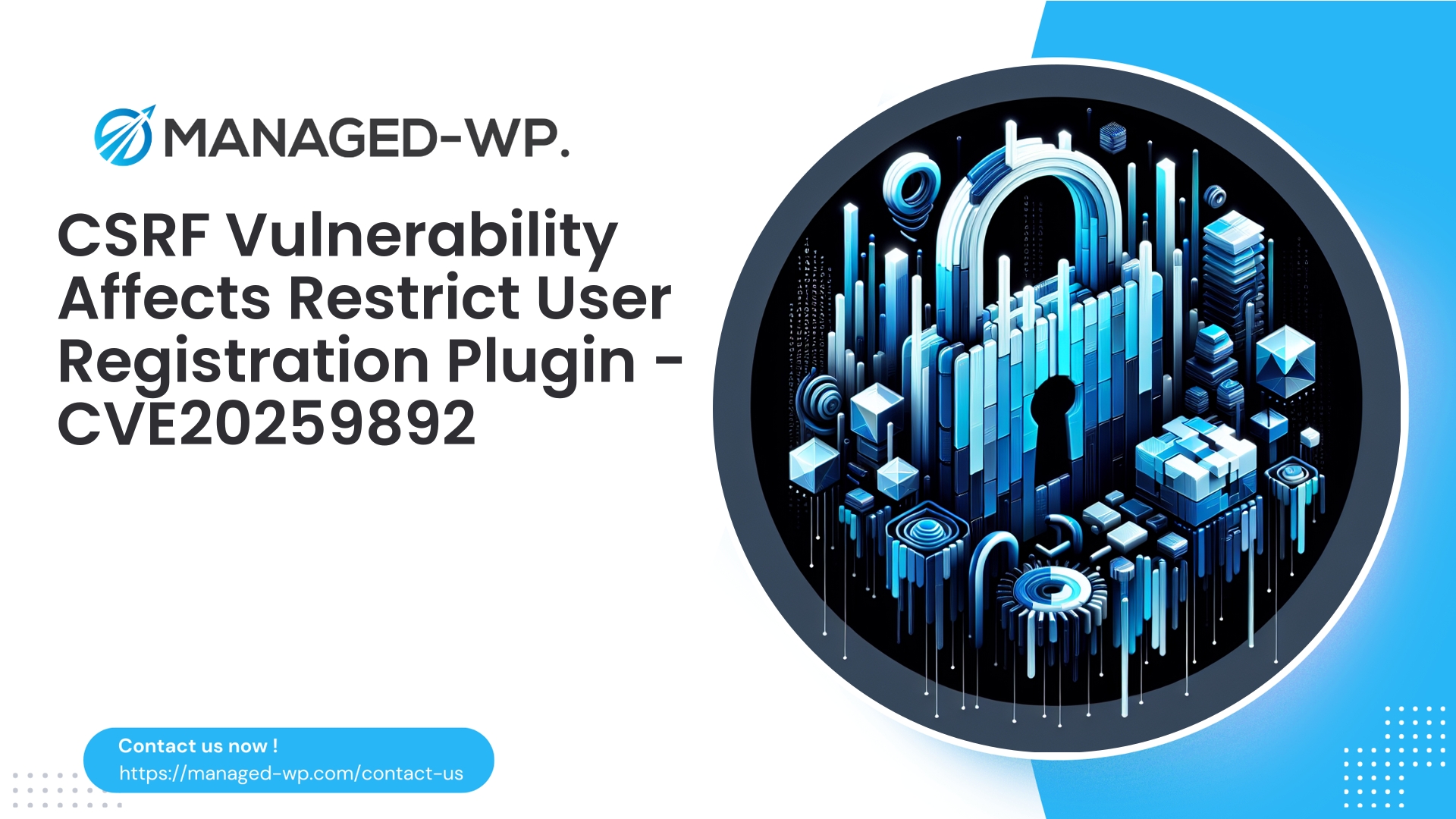| 插件名稱 | ContentMX 內容發佈器 |
|---|---|
| 漏洞類型 | 跨站請求偽造 (CSRF) |
| CVE編號 | CVE-2025-9889 |
| 緊急 | 低的 |
| CVE 發布日期 | 2025-10-03 |
| 來源網址 | CVE-2025-9889 |
緊急公告:ContentMX 內容發佈器 (≤1.0.6) 中的 CSRF 漏洞 — 關鍵資訊與託管 WP 保護指南
執行摘要: 影響 ContentMX Content Publisher WordPress 外掛程式 1.0.6 及更早版本的跨站請求偽造 (CSRF) 漏洞已被正式編入漏洞目錄,編號為 CVE-2025-9889。此漏洞允許攻擊者誘使已認證使用者在其網站上執行惡意操作,例如根據插件功能變更內容或配置設定。目前,官方尚未發布安全補丁。本簡報概述了漏洞的技術風險、常見利用途徑(不包括具體漏洞利用方法)、緊急緩解措施以及進階防禦措施(包括防火牆規則範例和最佳實踐),這些內容均來自 Managed-WP 安全團隊。
目錄
- 了解 CSRF 及其對 WordPress 外掛程式的影響
- 關鍵細節:ContentMX 內容發佈器漏洞 (CVE-2025-9889)
- 潛在的真實世界攻擊場景
- 立即採取的補救措施:接下來一小時內該做什麼
- 短期緩解措施(數小時至數天)
- 建議的WAF和虛擬補丁保護規則
- 伺服器級防禦策略(以 Apache/nginx 為例)
- 插件 CSRF 防護的長期安全最佳實踐
- 如果懷疑系統遭到入侵,請執行事件回應清單。
- Managed-WP 如何提供強大的保護
- 總結建議及其他資源
了解 CSRF 及其對 WordPress 外掛程式的影響
跨站請求偽造 (CSRF) 是一種攻擊,惡意網站或攻擊者誘騙已認證使用者的瀏覽器向目標應用程式發送非預期請求。在 WordPress 生態系統中,這通常意味著誘使管理員或具有特權的使用者在不知情的情況下執行某些操作,例如透過精心建構的連結或使用者在登入後造訪的頁面來修改設定、發佈內容或更改外掛程式資料。
為什麼插件特別容易受到攻擊:
- 插件通常會引入新的管理介面或 AJAX 端點。如果這些端點在缺乏強大的 CSRF 防護措施(例如伺服器端 nonce 驗證)的情況下執行關鍵狀態更改,它們就很容易成為攻擊目標。
- 插件開發者常常會忽略自訂表單處理程序或 AJAX 回呼中的 nonce 驗證。
- CSRF 攻擊依賴誘使有特權的使用者在不知情的情況下執行操作,任何擁有管理員或編輯權限的使用者都可能成為攻擊目標。
- 這種攻擊方式對攻擊者很有吸引力,因為它只需要極少的投入,而且可以大規模自動化。
重要提示: CSRF 漏洞的出現是因為缺少或不正確的請求來源驗證——如果一個端點接受執行更改的請求,而沒有透過 nonce、引用檢查或標頭來驗證使用者意圖,那麼它就容易受到攻擊。
關鍵細節:ContentMX 內容發佈器漏洞 (CVE-2025-9889)
- 類型: 跨站請求偽造 (CSRF)
- 受影響的插件: ContentMX WordPress 內容發佈器
- 受影響版本: 1.0.6 及以下版本
- CVE 參考編號: CVE-2025-9889
- 記者: 喬納斯·本傑明·弗里德利
- CVSS評分: 4.3(低)-情境因素可能增加實際風險
- 補丁狀態: 截至發稿時,尚未發布官方更新資訊。
- 所需權限: 受害者必須經過身份驗證(通常為管理員/編輯角色);某些端點可能不需要身份驗證,但保守假設將其視為已驗證場景。
- 影響概要: 攻擊者可以使擁有特權的使用者在不知情的情況下提交更改網站內容、配置或外掛程式行為的請求。
筆記: CVSS 評分提供標準化的嚴重性評估,但您的網站風險取決於使用者角色、接觸範圍和外掛程式使用情況。
潛在的現實世界影響情景
了解可能的攻擊手段有助於確定防禦的優先順序:
- 未經授權發布或更改內容:
- 攻擊者可以脅迫管理員發布垃圾郵件、竄改內容或惡意廣告。
- 外掛程式或網站配置被篡改:
- 攻擊者可能會更改資訊來源設定、重定向規則或外部 API 配置。
- 建立持久性後門:
- 惡意貼文或註入的腳本可能導致憑證被盜或遭受進一步攻擊。
- SEO與供應鏈濫用:
- 惡意SEO垃圾資訊植入可能會損害網站聲譽和搜尋排名。
- 權限提升鏈:
- CSRF 可以與其他漏洞結合使用,以提升存取權限或竊取資料。
雖然嚴重程度會隨著插件操作範圍的不同而變化,但即使 CVSS 評級為中等,風險仍然很大。
立即採取的補救措施—您必須在 60 分鐘內完成的事項
如果您的環境中包含 ContentMX 內容發佈器插件,請立即執行以下關鍵步驟:
- 驗證插件是否存在並已激活
- 使用權 WordPress 管理後台 → 外掛 → 已安裝插件 並確認「ContentMX 內容發佈商」身分。
- 如果遠端管理存取不安全,請透過 VPN 或 SSH 連線以降低風險。
- 如果插件處於活動狀態且這樣做安全,請立即停用該插件。
- 使用 WordPress 控制面板停用該外掛程式。
- 如果使用者介面存取被封鎖或遭到破壞,請透過 SSH/SFTP 重新命名外掛程式目錄:
mv wp-content/plugins/contentmx-content-publisher wp-content/plugins/contentmx-content-publisher.disabled
- 如果業務需求封鎖停用:
- 限制管理員使用者活動:減少活躍的管理員會話,並要求特權使用者在緩解措施實施之前避免進行網站管理。
- 內部溝通,暫時停止管理員權限使用。
- 立即輪換憑證:
- 重設所有管理者和特權帳戶的密碼。
- 使用會話管理外掛程式或 Managed-WP 管理工具使活動會話失效。
- 啟用多因素身份驗證 (MFA)
- 如果尚未啟用,請對所有管理員帳戶強制執行雙重認證,以降低帳戶被盜用的風險。
- 備份您的環境
- 為了確保資料完整性,在進行任何變更之前,請建立檔案和資料庫的完整異地備份。
這些緊急措施的重點是阻止剝削行為和收集證據。
短期緩解措施(數小時至數天)
如果無法立即更新外掛程式或外掛程式必須保持啟用狀態,請考慮以下緩解措施:
- 使用 Web 應用程式防火牆 (WAF) 或基於插件的防火牆進行虛擬修補
- 阻止或驗證對插件端點的 POST/GET 請求的來源,強制執行 nonce 或 referer 檢查。
- Managed-WP 客戶可無縫部署自訂虛擬修補規則,以阻止漏洞利用嘗試。
- 透過 IP 位址限制對管理員區域的訪問
- 透過伺服器或網路防火牆,將對 /wp-admin/ 和相關外掛程式管理頁面的存取權限限制在受信任的 IP 位址範圍內。
- 加強使用者角色和權限
- 減少管理員數量,並分配權限最低的編輯或撰稿人,以降低整體風險。
- 監控活動和稽核日誌
- 啟用管理員和外掛程式相關操作的完整日誌記錄,並審查可疑變更。
- 檢查內容和插件配置是否有異常。
- 禁用非必要的插件功能
- 在修復程式發布之前,請關閉可能暫時不需要的選用外掛功能。
- 在可行的情況下,增加人工 nonce 驗證。
- 如果熟悉插件程式碼,請插入伺服器端 WP nonce 檢查(
檢查管理員引用,wp_verify_nonce)到 POST 處理程序中。 - 警告: 只有在對插件開發有信心的情況下才能繼續進行,並且要保留原始文件的備份。
- 如果熟悉插件程式碼,請插入伺服器端 WP nonce 檢查(
建議的 WAF 和虛擬補丁規則
作為專業的安全服務供應商,Managed-WP 建議部署針對性的虛擬修補程式來阻止 CSRF 攻擊模式,同時不影響外掛程式的正常使用。以下是一些範例規則供您參考;請在部署到生產環境之前,先在測試環境中進行自訂和測試。
筆記: 這些是防禦性指導原則,不提供漏洞細節。
- 一般規則概念
- 拒絕指向缺少有效參數的插件端點的 POST 請求
_wpnonce參數或正確的引用來源。
- 拒絕指向缺少有效參數的插件端點的 POST 請求
- Apache/mod_security 範例
SecRule REQUEST_METHOD "POST" "phase:2,chain,deny,status:403,id:1001001,msg:'阻止 ContentMX CSRF - 缺少 nonce',log" SecRule REQUEST_URI "@contains /wp-contentcontent/plugins/msher/GS」 "@eq 0" SecRule REQUEST_METHOD "POST" "phase:2,chain,deny,status:403,id:1001002,msg:'阻止 ContentMX CSRF - 無效的引用頁',log" SecRule REQUEST_URI "@contains /wp-Fone/content-c8m. REQUEST_HEADERS:Referer "!@contains %{REQUEST_HEADERS:Host}"
解釋:
- 阻止向缺少 nonce 或來自外部引用來源的插件路徑提交 POST 請求。
- nginx 範例(簡單的按模式拒絕)
location ~* /wp-content/plugins/contentmx-content-publisher/ { if ($request_method = POST) { set $has_nonce 0; if ($arg__wpnonce != "") { set $has_nonce 14Targ__wp5 return 403; } if ($has_nonce = 0) { return 403; } } }
筆記: nginx「if」指令的細微差別需要在生產環境使用前進行徹底測試。
- WordPress 級防火牆(推薦)
- 阻止 POST 請求的情況:
- 請求目標是插件路徑或特定的已知操作參數(例如,
操作=contentmx_publish) - 且不存在有效的隨機數
- 並且引用標頭表明來源並非本地。
- 請求目標是插件路徑或特定的已知操作參數(例如,
- Managed-WP 用戶可受益於這些保護措施的自動部署和調整。
- 阻止 POST 請求的情況:
- 基於HTTP標頭的阻止(低風險啟發式方法)
- 許多 AJAX 請求都包含標頭
X-Requested-With: XMLHttpRequest由於透過 HTML 表單進行的 CSRF 攻擊可能會忽略此訊息,因此您可以阻止缺少此資訊的 POST 請求。 - mod_security 規則範例:
- 許多 AJAX 請求都包含標頭
SecRule REQUEST_URI "@contains contentmx" "phase:1,chain,deny,msg:'阻止 ContentMX 外掛程式的 AJAX 請求,不包含 X-Requested-With',id:1001003" SecRule REQUEST_METHOD "POST"DefinD 0"
注意:
- 頭部驗證可能會產生誤報;可作為多層防禦中的輔助控制措施。
伺服器級緩解措施(Apache/nginx 範例)
對於希望在伺服器端實施控制的網站,以下是一些實用的設定方法。
- 透過插件資料夾中的 .htaccess 檔案阻止外部 POST 請求(Apache)
請將以下內容放入
wp-content/plugins/contentmx-content-publisher/.htaccess:RewriteEngine On # 阻止來自外部引用頁的 POST 請求 RewriteCond %{REQUEST_METHOD} POST RewriteCond %{HTTP_REFERER} !^https?://(www\.)?your-domain\.com [NC] RewriteFule.代替
your-domain.com使用您網站的規範主機名稱。 - 透過 IP 位址限制管理員外掛程式檔案的存取權限(nginx)
location /wp-content/plugins/contentmx-content-publisher/admin/ { allow 192.0.2.0/24; # 替換為您信任的辦公室或 VPN IP 位址範圍 deny all; }只有受信任的IP位址才能存取這些敏感的管理路徑。
- 禁止直接透過 Web 存取插件 PHP 入口點
在適用情況下,阻止直接存取特定的 PHP 文件,並要求透過 WordPress 核心進行路由,以實現更安全的處理。
預防插件 CSRF 問題的長期安全最佳實踐
透過以下基礎措施來降低未來風險:
- 貫徹最小特權原則
- 僅分配必要的最低限度的角色和權限;避免共享管理員憑證。
- 強制使用多因素身份驗證 (MFA)
- 多因素身份驗證 (MFA) 可顯著降低因憑證被攔截或濫用而導致的安全風險。
- 盡量減少插件數量並保持更新
- 移除不必要或已停止維護的插件。測試後定期更新所有組件。
- 雇主管理的WAF解決方案
- Web 應用防火牆可即時緩解攻擊嘗試,並在供應商修復程式延遲時提供虛擬修補程式。
- 使用隨機數和能力檢查進行開發
- 插件開發必須包括
檢查管理員引用或者wp_verify_nonce驗證和用戶能力驗證以防止 CSRF。
- 插件開發必須包括
- 全面日誌記錄與監控
- 保留詳細的審計追蹤記錄,並對可疑活動發出警報。
- 定期備份和測試的恢復
- 備份程序能夠快速從系統漏洞或錯誤中復原。
- 插件安全審查
- 部署前,請先驗證第三方外掛程式的安全狀況,包括更新頻率和 CSRF 防護。
疑似系統入侵事件回應清單
如果您有理由相信漏洞已被利用,請立即按照以下清單進行檢查:
- 立即將網站置於維護模式,並限制管理員存取權限。
- 建立所有檔案和資料庫的異地備份,以進行取證分析。
- 收集並保存日誌(Web 伺服器日誌、PHP 錯誤日誌、插件日誌);記錄可疑活動時期。
- 輪換所有特權使用者和整合的密碼和 API 金鑰。
- 使用多種工具進行徹底的惡意軟體和 webshell 掃描。
- 審核最近的內容、選項和插件設置,是否有未經授權的更改。
- 如果發現系統遭到入侵的跡象,請恢復到已知的乾淨備份;在重新啟動之前,請加強環境安全。
- 聯絡託管安全團隊或主機供應商,以獲得遏制和恢復方面的支援。
- 僅在應用並驗證官方安全補丁後重新啟用插件。
Managed-WP 如何保護您的 WordPress 環境
在 Managed-WP,我們採用雙管齊下的方法來應對外掛程式 CSRF 風險,例如:
- 主動虛擬修補: 我們部署了經過精心調校的防火牆規則,能夠有效抵禦針對 ContentMX 內容發佈器的特定攻擊模式,所有操作均在 HTTP 請求層透明進行,無需修改外掛程式碼。這確保了網站運作不中斷,並將風險降至最低。
- 即時監控和警報: Managed-WP 會持續分析流量,以偵測異常的管理員要求和可疑模式。我們會立即通知您,以便您快速回應事件。
Managed-WP 方法的主要特點包括:
- 針對已知易受攻擊的插件路徑和缺少的 nonce/referer 模式量身定制的規則
- 自適應演算法可在保持防護的同時最大限度地減少誤報。
- 管理員和機構只需單擊即可跨多個站點進行部署
- 會話加固工具和基於 IP/地理位置的管理員存取控制
- 根據最新威脅情報持續更新
對於多站點營運商或客戶經理而言,虛擬修補程式提供了降低風險的最快途徑——通常不會造成停機或客戶中斷。
推薦給員工和顧客的訊息
與擁有管理權限的團隊成員進行清晰有效的溝通:
- 問題說明:“我們在 ContentMX 內容發佈插件(1.0.6 或更早版本)中發現了一個 CSRF 漏洞。我們正在立即採取措施保護網站,請您在另行通知之前暫停所有管理操作。”
- 請提供直接指示:“請退出 WordPress,並避免在公共或不受信任的網路上使用管理員帳戶。密碼重設功能即將強制執行。”
- 描述當前措施:“我們正在停用該插件,應用 Managed-WP 虛擬補丁,並限制管理員訪問權限,等待插件供應商的官方更新。”
清晰的溝通有助於防止可能助長剝削的意外行為。
立即使用 Managed-WP Basic(免費)保護您的網站
對於希望在準備或等待外掛程式修補期間獲得額外保護的網站擁有者而言,Managed-WP Basic 可免費提供必要的防禦措施。這些措施包括託管防火牆、無限頻寬、全面的 Web 應用程式防火牆 (WAF) 功能、惡意軟體掃描以及針對 OWASP 主要漏洞的緩解措施——旨在降低 ContentMX CSRF 漏洞等風險帶來的影響。
升級後的方案提供自動惡意軟體清理、IP 允許/拒絕功能、進階虛擬修補程式、詳細的每月安全報告和託管服務。
點擊這裡了解並註冊免費方案:
https://my.wp-firewall.com/buy/wp-firewall-free-plan/
需要協助評估風險或部署虛擬修補程式?我們專業的託管WP安全團隊隨時準備協助您保護環境。
最終建議和結語
- 迅速行動: 對於運行存在漏洞的插件的網站,立即停用或部署虛擬修補程式是降低風險的最快方法,直到供應商的修復程式發佈為止。
- 採取縱深防禦: CSRF 只是眾多攻擊途徑之一。要實現全面的安全防護,需要部署 Web 應用防火牆 (WAF)、多因素身份驗證 (MFA)、最小權限原則、備份以及及時更新等措施。
- 徹底測試: 在套用防火牆或伺服器設定調整後,驗證所有關鍵管理工作流程是否正常運作。
- 維護和保護日誌: 如果懷疑有安全漏洞,請收集並保存日誌和備份以支援調查。
如果您管理多個 WordPress 網站或客戶環境,請考慮使用 Managed-WP 的虛擬修補程式和託管服務,以便在外掛程式供應商修復週期內有效保護您的安裝。
保持警惕,執行這些建議,並聯繫 Managed-WP 支援團隊以獲取緩解措施的協助。
— Managed-WP 安全團隊



















